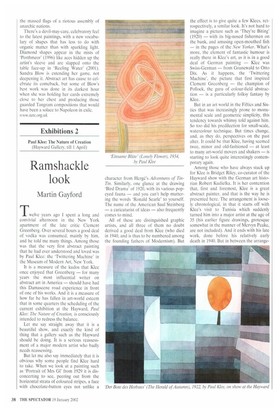Sandra Blow (Tate St Ives. till 10 March)
Back to basics
Laura Gascoigne
In modern life progress is only made by slamming doors on the immediate past, so it's natural, though still rather surprising, that Modernism and Post-Modernism should be the worst of enemies. In the struggle between painting and conceptual art it's abstraction, not figuration, that has come off worst because, when the chips are down, figurative art is at least about something (and so susceptible to irony) whereas abstract art, with its veneration of the art object, is a crime against everything postModernism stands for. If abstraction is now being rehabilitated, that may be partly due to the post-post-modern irony that, thanks to the electromicrograph, its vocabulary of 'pure' forms has been revealed to have striking similarities to the basic building blocks of life. In other words, without its practitioners knowing it, abstract art has turned out to be about something after all.
This is good news for an artist like Sandra Blow who has always painted around things rather than about them. As a young abstract painter in Cornwall in the late 1950s, Blow would prop her canvases against her barn studio door so that her surroundings could get into them despite her — and get into them they did, in the form of the bits of chaff and farmyard sacking littering the surfaces of paintings such as 'Cornwall' (1958) and 'Space and Matter' (1959). These are the earliest works in her new show at Tate St Ives and the ones most closely tied to reality in their Lanyonesque relation to the landscape. In the 1960s she cut the cord to representation and since then she has been out on her own.
Blow's pictures have nothing to do with illusion — what things are not — and everything to do with what they are at their most stripped down, basic and elemental, when reduced to form, weight, texture, colour and the relations between them. At different periods she has adopted different strategies for dealing with these fundamentals in paint, but has always been uncompromising in her refusal to play illusory peekaboo games with depth. There's not even the teensiest hint of perspective in Blow's work to draw us in and make us forget ourselves: we're left with all our critical faculties intact to judge its success entirely on its own merits. This is painting without a safety net when it fails, it's liable to fall flatter than flat.
The Tate's show is a retrospective with sizeable gaps. From the 1950s sackclothand-ashes period inspired by her first Italian mentor, Alberto Burn, we leapfrog the down-and-dirty phase of oil and charcoal drawings influenced by her friendship with Roger Hilton, skip the mid-Sixties tea break when she produced her most minimal canvases stained with tea and ash, and, by way of the big, bold, ground-breaking collage 'Green and White' (1969), jump to 1982. Here earlier strands in her work seem to come together in a series of five square canvases which combine the gritty physical matiere of her Burn i period with the oriental delicacy of her tea paintings in ultra-simple configurations of collaged, painted and plastered elements. The effect is reminiscent of the ancient Chinese Tangram puzzles that swept the West a century before abstraction, capturing the visual imaginations of Lewis Carroll, Henry James and Napoleon (in exile). In the Tangram, seven geometric shapes are released from a square to form an infinite variety of configurations. In Blow's version, they remain in the square, and surplus shapes are discarded to make space. In 'Sacking, Indigo and White' or 'Sacking, Brown and White' a few simple shapes rest in a white triangle within the picture square, like pieces lodged where they have fallen in a kaleidoscope. (As Blow composes her pictures by taking polaroids and turning them round until the components fall into place, this pattern of distribution coincides with her working practice.) Most of the 1982 series is subdued in colour, but 'Red and White' gives a hint of what's to follow in the jubilant strides of red and blue skipping and splashing across the surface of `Vivace' (1988) and 'Glad Ocean' (1989). In the 1990s a dark, Italian shadow falls across the unusually figurative 'SeIva Oscura' (1993), but colour breaks out again after a move to St Ives in 1994 and emerges triumphant in the 12-part work 'Re-Sounding' commissioned for this show, a grid of dazzling squares of pink, orange, yellow, blue and green acrylic crossed with haphazard bars of white, like the massed flags of a riotous assembly of anarchic nations.
There's a devil-may-care, celebratory feel to the latest paintings, with a new vocabulary of shapes that has less to do with organic matter than with sparkling light. Diamond shapes appear in the mists of Torthmeor' (1996) like aces hidden up the artist's sleeve and are slapped onto the table face-up in 'Reeling Water' (2001). Sandra Blow is extending her game, not deepening it. Abstract art has cause to celebrate its comeback, but some of Blow's best work was done in its darkest hour when she was holding her cards extremely close to her chest and producing those guarded Tangram compositions that would have been a solace to Napoleon in exile. www.tate.org.uk































































 Previous page
Previous page